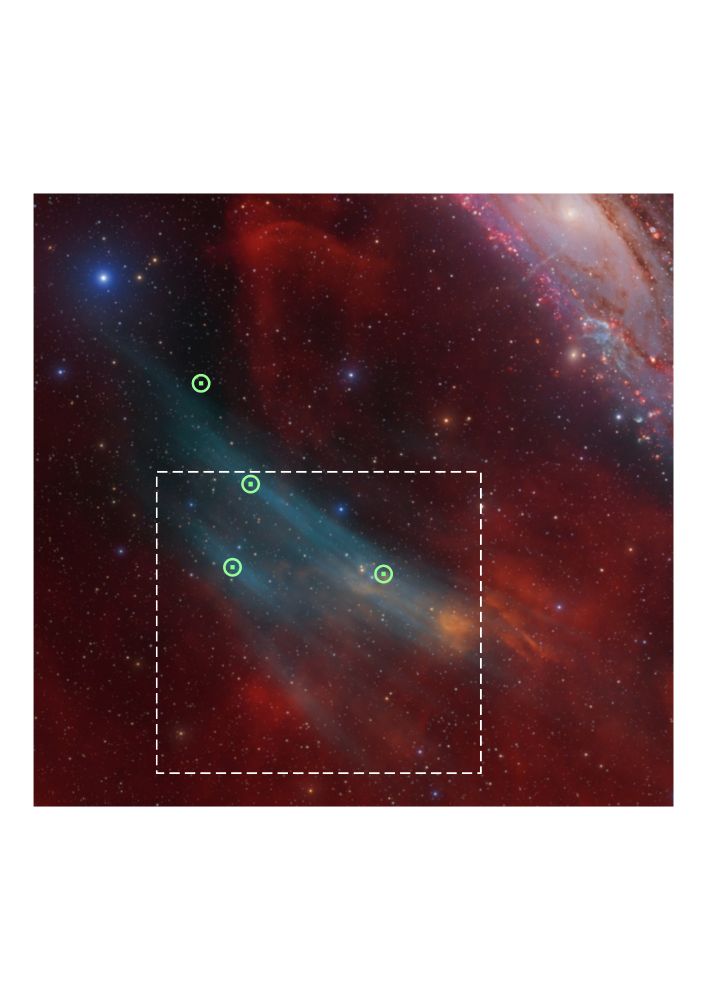
Even before us, others published different results (arxiv.org/abs/2303.09425 and arxiv.org/abs/2307.06308).
I think the nebula still remains (a bit) mysterious!
Even before us, others published different results (arxiv.org/abs/2303.09425 and arxiv.org/abs/2307.06308).
I think the nebula still remains (a bit) mysterious!
You can read a bit more about it in the thread I wrote when we presented the paper: bsky.app/profile/alum...
Today we try to decipher it! It's ✨Paper Day✨
arxiv.org/abs/2412.08327
With spectra from GTC (the largest 🔭) and OAJ large narrowband images we find the nebula is actually not related to M31!
But how?👇
#Astrophysics

You can read a bit more about it in the thread I wrote when we presented the paper: bsky.app/profile/alum...
And here is a thread explaining it:
bsky.app/profile/alum...
Today we try to decipher it! It's ✨Paper Day✨
arxiv.org/abs/2412.08327
With spectra from GTC (the largest 🔭) and OAJ large narrowband images we find the nebula is actually not related to M31!
But how?👇
#Astrophysics

And here is a thread explaining it:
bsky.app/profile/alum...
We used also a telescope from the OAJ (Teruel, Spain). And we are not sure of what it is exactly, but it does seem to be in the Milky Way.
For more info, the paper arxiv.org/abs/2412.08327 and my thread 👇
bsky.app/profile/alum...
Today we try to decipher it! It's ✨Paper Day✨
arxiv.org/abs/2412.08327
With spectra from GTC (the largest 🔭) and OAJ large narrowband images we find the nebula is actually not related to M31!
But how?👇
#Astrophysics

We used also a telescope from the OAJ (Teruel, Spain). And we are not sure of what it is exactly, but it does seem to be in the Milky Way.
For more info, the paper arxiv.org/abs/2412.08327 and my thread 👇
bsky.app/profile/alum...
We aren’t sure! It is a complex object, we haven't found anything like it before. It may be a gas filament in our galaxy, with an extra ionization source to explain the [OIII] emission.
More research is needed! 🔭
We aren’t sure! It is a complex object, we haven't found anything like it before. It may be a gas filament in our galaxy, with an extra ionization source to explain the [OIII] emission.
More research is needed! 🔭
This also suggests it’s probably not a supernova remnant or a planetary nebula.🔭
This also suggests it’s probably not a supernova remnant or a planetary nebula.🔭
This consistency is more typical of smaller nebulae nearby, rather than very distant and large ones.
🔭

This consistency is more typical of smaller nebulae nearby, rather than very distant and large ones.
🔭
This is something seen in other nebulae… but only if they are close to us, not if they are as far as M31!
![Image from Lumbreras-Calle et al. 2024 https://arxiv.org/abs/2412.08327. It shows, in the background the [OIII] (in blue) and Halpha (in red) emission from the nebula near M31 discovered by Strottner, Dreschler, and Sainty. In the foreground, in blue/red contours, it shows the [OII]/Halpha emission measured with the JAST80 telescope from @CEFCA_OAJ. There is a clear separation between the [OII] and [OIII] emission.](https://cdn.bsky.app/img/feed_thumbnail/plain/did:plc:2pkpjtru5xppw6znquqtjfgg/bafkreigxytmx22r2fec2p6p3rh6kkryryhf26cmnvw6j6qdqlcmrg4jc5y@jpeg)
This is something seen in other nebulae… but only if they are close to us, not if they are as far as M31!
This suggests it's a regular nebula nearby, not a distant giant one. A bit like a forced perspective trick!
🔭

This suggests it's a regular nebula nearby, not a distant giant one. A bit like a forced perspective trick!
🔭
I remember the comments for my first paper and it was brutal as well. I think about it every time I review something!
I remember the comments for my first paper and it was brutal as well. I think about it every time I review something!

